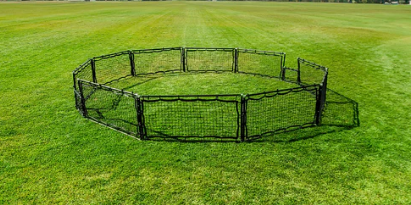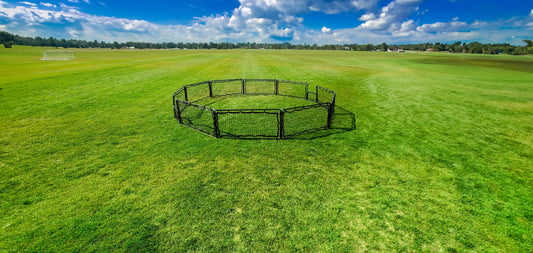Soccer is the third most popular televised sport, and over 25 million people in the United States play on soccer teams. The sport is competitive, fast-paced, and involved intensive teamwork--it's easy to fall in love with the sport. Here are the best types of training equipment for successful soccer teams.
Purpose of Soccer Training Equipment
From young children to adults, everyone can find joy in playing soccer. Fourteen percent of kids enrolled in sports between the ages of six and 18 are enrolled in soccer. However, if a kid wants to excel in soccer, the coach needs to supply training equipment to sharpen their skills, improve their footwork, and increase their reaction speed.
There are some training equipment options that every coach uses, such as soccer balls (which are essential), goals, jerseys, and cones. A soccer player might also choose to invest in a shin guard, goalie gloves, or cleats. Although gear like cleats and goalie gloves are expected of the players, the coach must provide the vast bulk of training equipment.
Using soccer training equipment during a practice session can help players refine their skills. This article is meant to provide a new coach with the necessary materials and starter-kit to give their team a chance to improve. 
Best Age to Introduce Soccer Training Equipment
Professional coaches recommend introducing soccer to kids between the ages of three and five years old. Introducing soccer to kids while they're young encourages them to develop a love for the game. It also helps them to stay fit and learn hand-foot coordination.
However, you won't need training equipment for a team of three-year-old children. When working with a very young player, you will just need a soccer field and a soccer ball. Instead of pushing the kids through agility training and speed hurdles, focus on teaches the basics of the game.
Some simple soccer activities for teams of young kids include:
- Pass the Ball:
First, practice passing the ball. Gather the kids into partners and have them kick the ball back and forth. This activity is simple with no rules or competition. It encourages the kids to focus.
- Hit the Coach:
This fun game teaches the kids to aim. Line the kids up and stand several feet away. The kids will have to dribble the ball forward and then kick the ball to your feet or shins. Once they kick, they go to the back of the line.
- Guard the Spaceship:
Place an upside-down basket in the middle of the field and choose two players at a time to defend. All other players have a ball. The other players try to kick their balls at the basket while the defenders kick the balls away (pretending that the soccer balls are bombs).
Young kids learn best when you encourage them to use their imagination. Instead of buying tools and equipment, play games that teach similar skills. Once the kids have accomplished basic soccer skills, you can begin introducing soccer training equipment. 
11 Best Soccer Training Resources
Here are ten of the best soccer training gear for new coaches.
1. Panna Cage (Gaga Ball Pit)
Panna, also known as nutmeg, is a popular street soccer game where players aim to pass the ball through the opponent's legs. The game is played in a small space, often one-on-one or two-on-two. While there may be variations in the rules depending on the region or individual preferences, here are the general rules of Panna:
- Objective: The objective of the game is to score points by successfully nutmegging or passing the ball through the opponent's legs while maintaining control of the ball.
- Playing Area: Panna is typically played in a small, confined space, such as a small court or cage. The size may vary, but it is usually a small area to encourage close control and quick movements.
- Number of Players: Panna can be played as a one-on-one or two-on-two game.
- Duration: The game is usually played to 3 minutes or a predetermined number of points. The duration or points may vary depending on the agreement between players.
- Scoring: Points are scored when a player successfully passes the ball through their opponent's legs. This is commonly referred to as a "panna." Each panna typically counts as one point. Some variations may assign higher points for special moves or specific conditions.
- Ball Control: Players must maintain control of the ball while attempting to nutmeg their opponent. They can use various techniques, such as dribbling, feints, and quick movements, to create opportunities for a panna.
- Fouls: While Panna is generally a non-contact game, some fouls may be considered depending on the agreed-upon rules. Common fouls include physically obstructing the opponent, intentionally tripping or kicking the opponent, or any aggressive or dangerous behavior. Fouls may result in the opposing player gaining possession or a penalty against the offending player.
- Out-of-Bounds: If the ball goes out of bounds, the opposing player is awarded possession through a throw-in, kick-in, or any agreed-upon method.
- Sportsmanship: Panna is often played in a friendly and competitive spirit. Good sportsmanship is encouraged, and players should respect their opponents and the rules of the game.

2. Soccer Training Ladder
One of the best ways to improve players' skills is by using a soccer training ladder. Soccer training ladders improve players' agility by teaching them to move quickly and precisely. To use a soccer speed ladder, have the player stand sideways on the ladder with both feet in the first square. The players will then move sideways through the ladder, making sure that each foot lands in every square one time.
The goal is to move through the ladder as quickly as possible while emphasizing good posture and balance. Repeat the drill several times until all the players have mastered their footwork and agility. 
3. Soccer Goal Target Sheets
A soccer soal target sheet is a sheer sheet that you can hook onto a soccer net. The sheet has rimmed holes for the soccer to pass through. However, if a player doesn't aim for one of the rimmed holes, the ball will hit the sheet and bounce off.
Using a soccer goal target sheet is perfect for training players to shoot at the goal while the goalies are off training elsewhere. If you don't have access to a goalie, this is the perfect tool. To use it, line up half the team to the goal's side and the other half facing the goal. Those to the side will pass the ball to the second line, who will then shoot it at one of the targets on the goal sheet. When one person finishes in one line, they go to the back of the second line, creating a perfect circuit.
A soccer goal target sheet is an invaluable resource for any team. 
4. Soccer Goal Target Bag
A target bag is similar to a target sheet--the main difference is that the target bag hangs from one part of the goal and has a bag to collect soccer balls. The drill is similar to a target sheet drill. Line up your players and have them shoot for the target bag. You can also add additional rewards, such as, "Each ball that makes it into the bag gets us out of practice 15 seconds earlier."
The soccer goal target bag is a great resource that is slightly more portable than the target sheet. It's perfect for smaller teams and precision training. 
5. Agility Poles
The best soccer equipment for agility and dribbling is agility poles. Agility poles are tall, flexible poles that you can set on the ground. You can set up the poles in a random square area or straight line for the players to weave between. Using agility poles encourages the players to learn how to dribble while avoiding obstacles.
Because the poles are fixed in place, the players must move and rotate their bodies while passing the ball from foot to foot. Using agility poles in your training session will teach your team to have better footwork and coordination dribbling. 
6. Soccer Passing Arcs
Soccer passing arcs are small arms that you can press into the ground. The arcs are the perfect height for soccer balls to pass under unheaded. Two players can run down on opposite sides the arcs and pass the ball back and forth through each one. Using soccer passing arcs in your practice helps players to perfect their passing and aim. To use the soccer gear to perfect a soccer skill, set up a fairly simple drill.
Let the players chose their partner and have the partners pass the ball back and forth through the passing arcs while running down the field. If a partner set misses the arch, they have to start over from the beginning, encouraging them to focus on ball control.
Soccer passing arcs are a great training add for a variety of soccer drills. 
7. Resistance Speed Chute
Using a resistance speed chute is a fun yet demanding training tool. Speed chutes are small parachutes that players can wear on their backs. When the players run, the chute gathers wind resistance, forcing the player to slow down and push even more energy into the sprint. When the same player takes the chute off, they will feel like they're flying down the field without any resistance.
Players wearing resistance speed chutes during warmup runs can increase their foot speed during practice, making them more agile. For a speed chute drill, start by timing the players on how quickly they can run from one side of the field to the other. Then, put on the resistance chute and encourage them to match their time. 
8. Reflex Reaction Ball
Reflex balls are the perfect training tool for goalies. Goalies are one of the most important players on your soccer team--without them, your team's defense would fall apart. Reflex balls teach your goalie to expect the unexpected and react automatically.
A reflex ball has an unpredictable bounce. While a soccer ball will bounce in a predictable pattern, a reflex ball bounces erratically, causing the goalie to stay on their toes.
9. Pop-Up Soccer Goals
Having a pop-up soccer goal or two is essential for when your soccer team travels from one area to the next. It's also helpful for running multiple drills at the same time. A pop-up soccer goal is extremely portable and can be carried in a small carrying case. When your team moves to a new field for a friendly scrimmage, bring the soccer goals to practice before the game.
During regular soccer practice, you can use the pop-up soccer goals to split the team into smaller groups. Having pop-ups means that your team can be versatile, whether or not you have access to a full soccer net. 
10. Soccer Rebounder Net
A soccer rebounder net is perfect for when you're splitting the team into circuit groups. The rebound net helps the players practice passing, shooting, and reacting. Rebounder nets are small or large nets with a trampoline netting in the center. When a player hits the net, the ball bounces back towards them.
For this drill, set up the rebounder net as part of the circuit. Have several players kick at the rebounder net while others are running speed hurtles or the agility ladder. 
11. Speed Hurdles
Speed hurdles are perfect for any agility-related sport, including football and soccer. The hurdles lift 12 inches off the ground and are shatterproof. Players can set up the hurdles on the grass and jump over them one at a time. Players are encouraged to jump through the speed hurdles as quickly as possible.
The constant jumping improves the players' jumping height, foot coordination, and lateral movement. They are a great addition to any successful practice.

Other Sports
If you're looking for some other fun sports to play. Check out Castle Squares and Froggy Ball.







